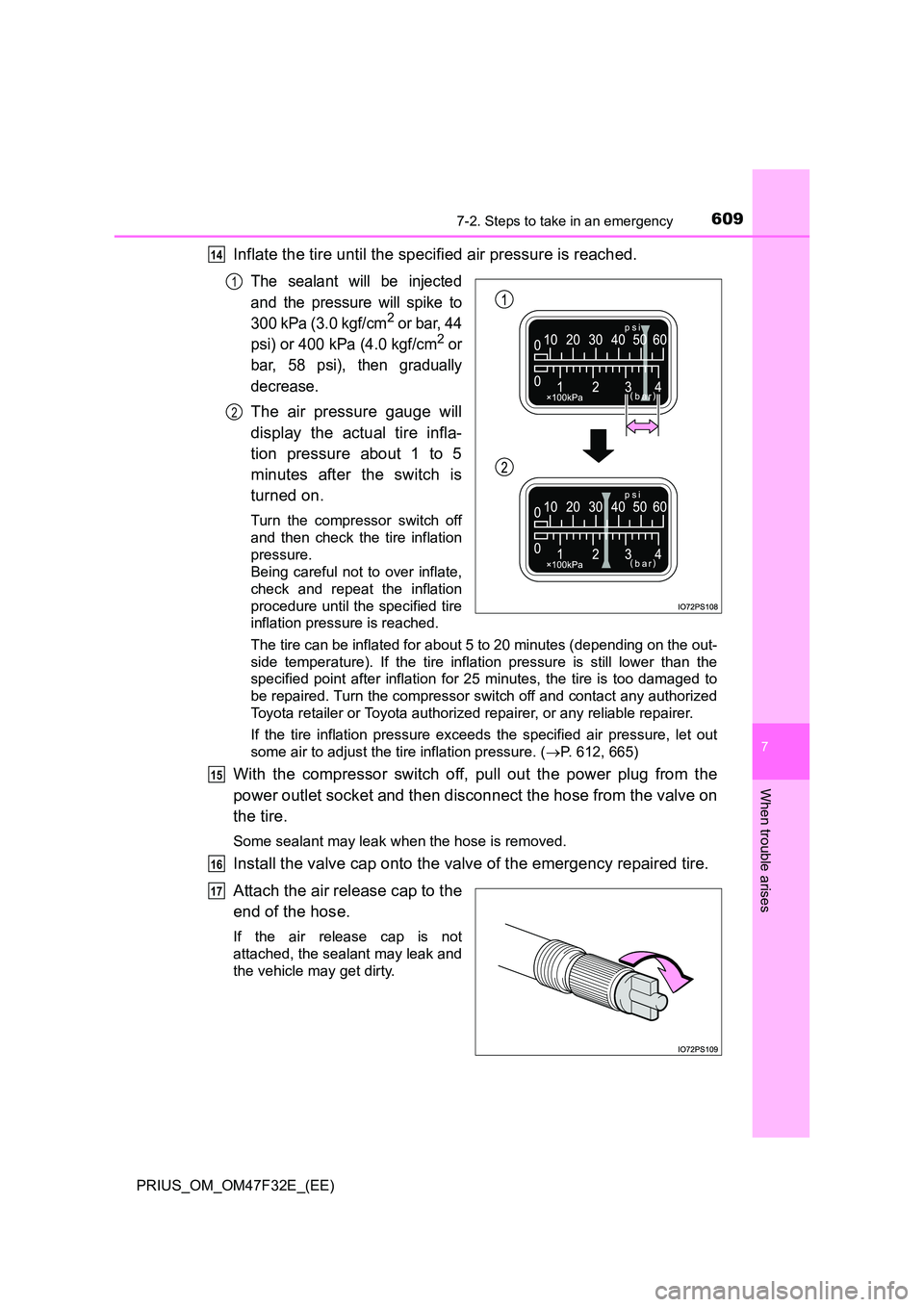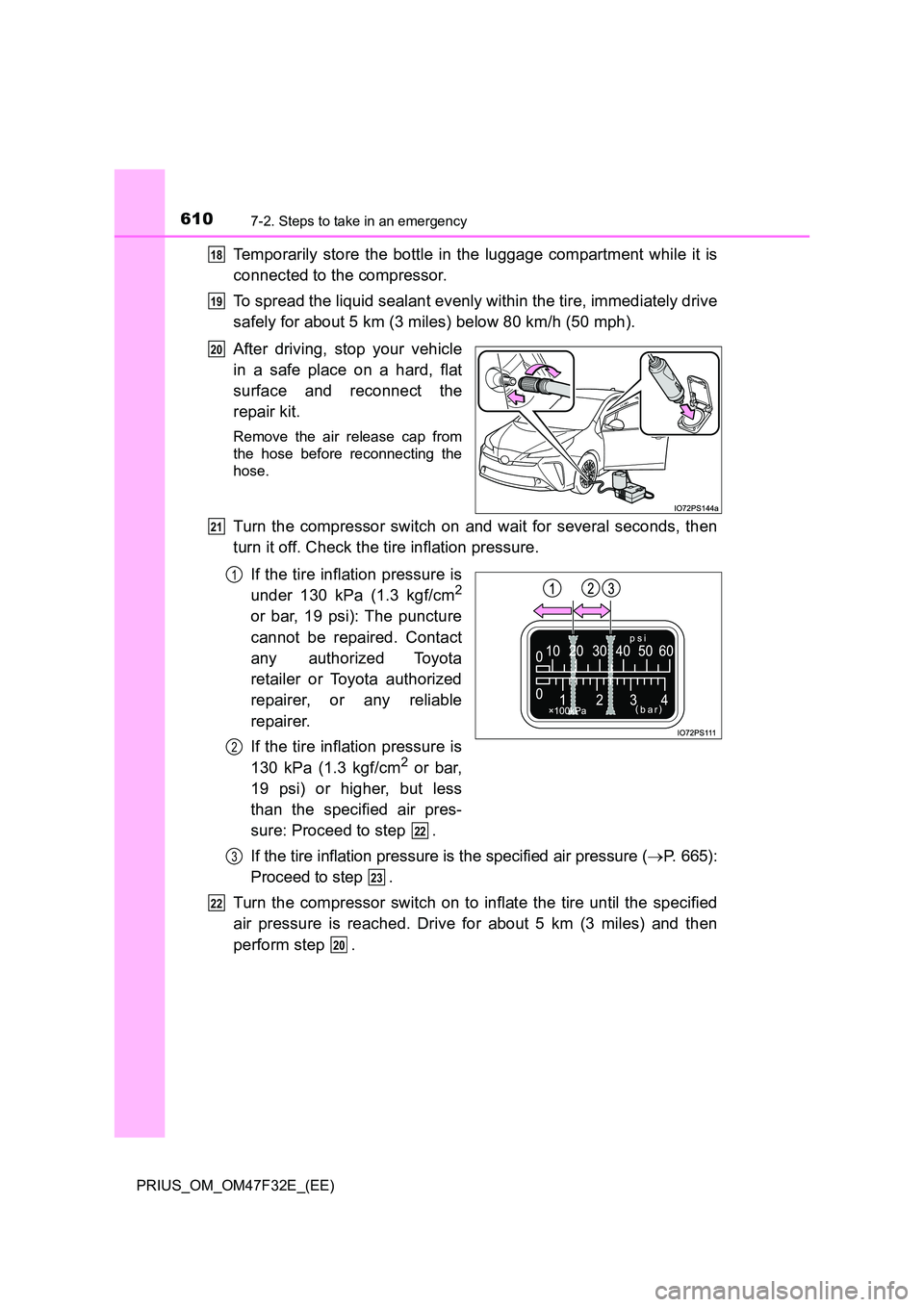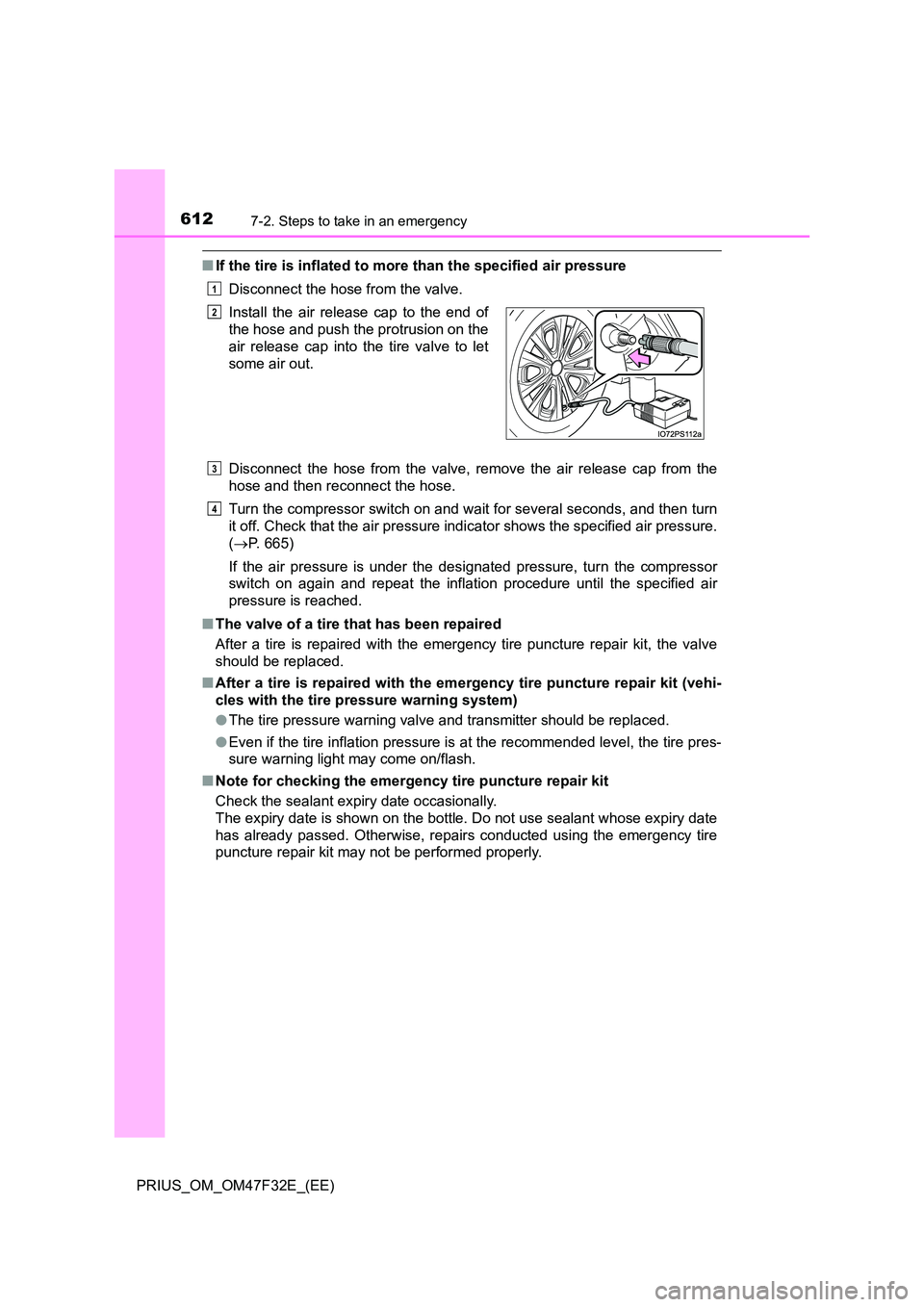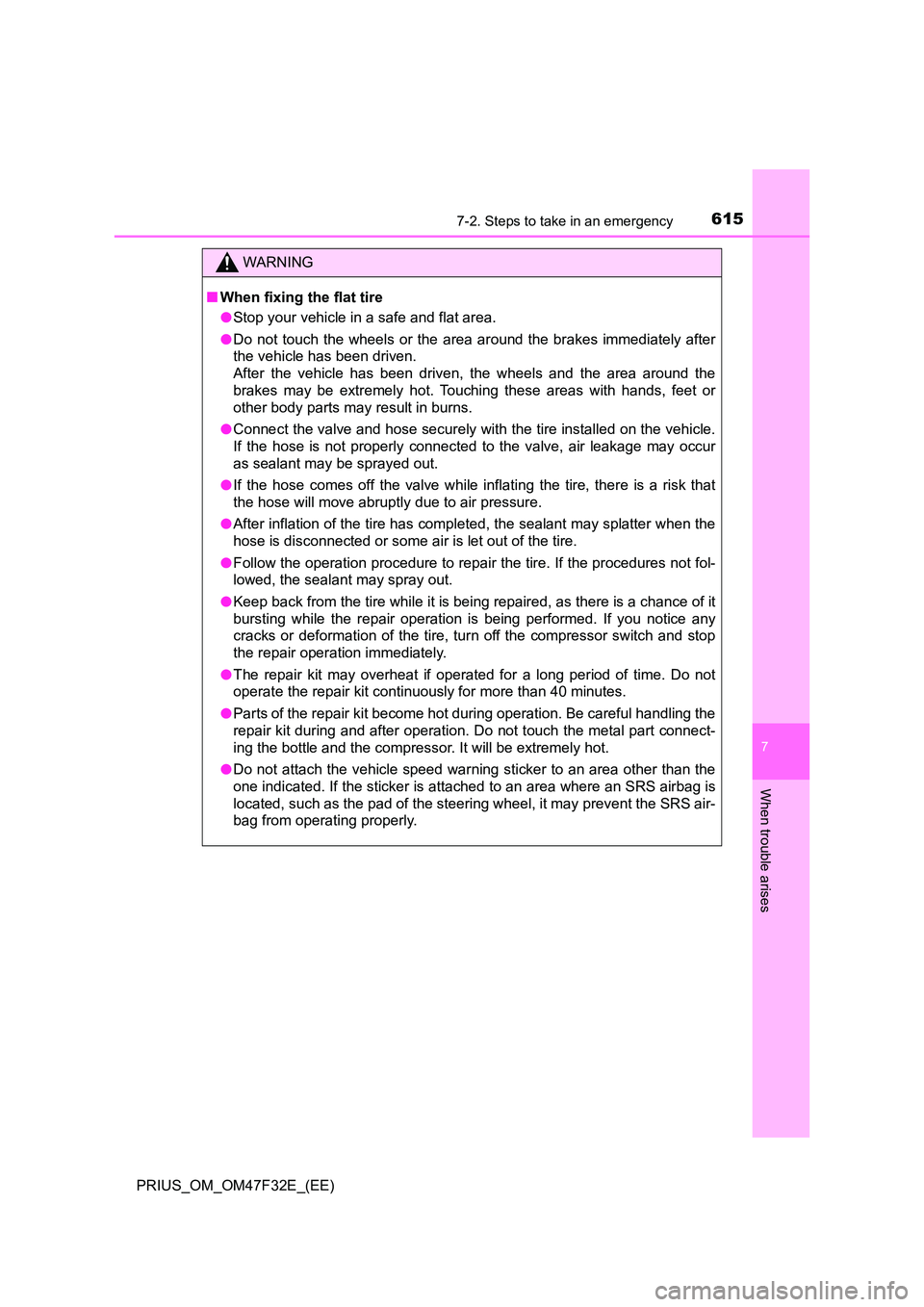Page 601 of 770

5997-2. Steps to take in an emergency
PRIUS_OM_OM47F32E_(EE)
7
When trouble arises
●Stop the vehicle in a safe place on a hard, flat surface.
● Set the parking brake.
● Shift the shift position to P.
● Stop the hybrid system.
● Turn on the emergency flashers.
● Check the degree of the tire damage.
A tire should only be repaired
with the emergency tire punc-
ture repair kit if the damage is
caused by a nail or screw pass-
ing through the tire tread.
• Do not remove the nail or
screw from the tire. Remov-
ing the object may widen the
opening and make emer-
gency repair with the repair
kit impossible.
• To avoid sealant leakage, move the vehicle until the area of the
puncture, if known, is positioned at the top of the tire.
■ A flat tire that cannot be repaired with the emergency tire puncture repair
kit
In the following cases, the tire c annot be repaired with the emergency tire
puncture repair kit. Contact any authorized Toyota retailer or Toyota autho-
rized repairer, or any reliable repairer.
● When the tire is damaged due to driving without sufficient air pressure
● When there are any cracks or damage at any location on the tire, such as on
the side wall, except the tread
● When the tire is visibly separated from the wheel
● When the cut or damage to the tread is 4 mm (0.16 in.) long or more
● When the wheel is damaged
● When two or more tires have been punctured
● When more than one sharp objects such as nails or screws have passed
through the tread on a single tire
● When the sealant has expired
Before repairing the tire
Page 604 of 770
6027-2. Steps to take in an emergency
PRIUS_OM_OM47F32E_(EE)
Emergency tire puncture repair kit components
Bottle
Sticker
Compressor
Air pressure gauge
Compressor switch
Power plug
Hose
Air release cap
1
2
3
4
5
6
7
8
Page 610 of 770
6087-2. Steps to take in an emergency
PRIUS_OM_OM47F32E_(EE)
Check the specified tire inflation pressure.
Tire inflation pressure is specified on the label as shown. (P. 665)
Start the hybrid system. (P. 244)
To inject the sealant and inflate
the tire, turn the compressor
switch on.
11
Left-hand drive vehiclesRight-hand drive vehicles
12
13
Page 611 of 770

6097-2. Steps to take in an emergency
PRIUS_OM_OM47F32E_(EE)
7
When trouble arises
Inflate the tire until the specified air pressure is reached.
The sealant will be injected
and the pressure will spike to
300 kPa (3.0 kgf/cm2 or bar, 44
psi) or 400 kPa (4.0 kgf/cm2 or
bar, 58 psi), then gradually
decrease.
The air pressure gauge will
display the actual tire infla-
tion pressure about 1 to 5
minutes after the switch is
turned on.
Turn the compressor switch off
and then check the tire inflation
pressure.
Being careful not to over inflate,
check and repeat the inflation
procedure until the specified tire
inflation pressure is reached.
The tire can be inflated for about 5 to 20 minutes (depending on the out-
side temperature). If the tire inflation pressure is still lower than the
specified point after inflation for 25 minutes, the tire is too damaged to
be repaired. Turn the compressor switch off and contact any authorized
Toyota retailer or Toyota authorized repairer, or any reliable repairer.
If the tire inflation pressure exceeds the specified air pressure, let out
some air to adjust the tire inflation pressure. ( P. 612, 665)
With the compressor switch off, pull out the power plug from the
power outlet socket and then disconnect the hose from the valve on
the tire.
Some sealant may leak when the hose is removed.
Install the valve cap onto the valve of the emergency repaired tire.
Attach the air release cap to the
end of the hose.
If the air release cap is not
attached, the sealant may leak and
the vehicle may get dirty.
14
1
2
15
16
17
Page 612 of 770

6107-2. Steps to take in an emergency
PRIUS_OM_OM47F32E_(EE)
Temporarily store the bottle in the luggage compartment while it is
connected to the compressor.
To spread the liquid sealant evenly within the tire, immediately drive
safely for about 5 km (3 miles) below 80 km/h (50 mph).
After driving, stop your vehicle
in a safe place on a hard, flat
surface and reconnect the
repair kit.
Remove the air release cap from
the hose before reconnecting the
hose.
Turn the compressor switch on and wait for several seconds, then
turn it off. Check the tire inflation pressure.
If the tire inflation pressure is
under 130 kPa (1.3 kgf/cm2
or bar, 19 psi): The puncture
cannot be repaired. Contact
any authorized Toyota
retailer or Toyota authorized
repairer, or any reliable
repairer.
If the tire inflation pressure is
130 kPa (1.3 kgf/cm2 or bar,
19 psi) or higher, but less
than the specified air pres-
sure: Proceed to step .
If the tire inflation pressure is the specified air pressure ( P. 665):
Proceed to step .
Turn the compressor switch on to inflate the tire until the specified
air pressure is reached. Drive for about 5 km (3 miles) and then
perform step .
18
19
20
21
1
2
22
3
23
22
20
Page 614 of 770

6127-2. Steps to take in an emergency
PRIUS_OM_OM47F32E_(EE)
■If the tire is inflated to more than the specified air pressure
Disconnect the hose from the valve.
Disconnect the hose from the valve, remove the air release cap from the
hose and then reconnect the hose.
Turn the compressor switch on and wait for several seconds, and then turn
it off. Check that the air pressure indicator shows the specified air pressure.
( P. 665)
If the air pressure is under the designated pressure, turn the compressor
switch on again and repeat the inflation procedure until the specified air
pressure is reached.
■ The valve of a tire that has been repaired
After a tire is repaired with the emer gency tire puncture repair kit, the valve
should be replaced.
■ After a tire is repaired with the emergency tire puncture repair kit (vehi-
cles with the tire pressure warning system)
● The tire pressure warning valve and transmitter should be replaced.
● Even if the tire inflation pressure is at the recommended level, the tire pres-
sure warning light may come on/flash.
■ Note for checking the emergency tire puncture repair kit
Check the sealant expiry date occasionally.
The expiry date is shown on the bottle. Do not use sealant whose expiry date
has already passed. Otherwise, repairs conducted using the emergency tire
puncture repair kit may not be performed properly.
Install the air release cap to the end of
the hose and push the protrusion on the
air release cap into the tire valve to let
some air out.
1
2
3
4
Page 615 of 770

6137-2. Steps to take in an emergency
PRIUS_OM_OM47F32E_(EE)
7
When trouble arises
■Emergency tire puncture repair kit
● The emergency tire puncture repair kit is for filling the car tire with air.
● The sealant has a limited life span. The expiry date is marked on the bottle.
The sealant should be replaced before the expiry date. Contact any autho-
rized Toyota retailer or Toyota authorized repairer, or any reliable repairer for
replacement.
● The sealant stored in the emergency tire puncture repair kit can be used
only once to temporarily repair a single tire. If the sealant in the bottle and
other parts of the kit have been used and need to be replaced, contact any
authorized Toyota retailer or Toyota authorized repairer, or any reliable
repairer.
● The compressor can be used repeatedly.
● The sealant can be used when the outside temperature is from -40°C (-40°F)
to 60°C (140°F).
● The kit is exclusively designed for size and type of tires originally installed
on your vehicle. Do not use it for tires that a different size than the original
ones, or for any other purposes.
● If the sealant gets on your clothes, it may stain.
● If the sealant adheres to a wheel or the surface of the vehicle body, the stain
may not be removable if it is not cleaned at once. Immediately wipe away
the sealant with a wet cloth.
● During operation of the repair kit, a loud operation noise is produced. This
does not indicate a malfunction.
● Do not use to check or to adjust the tire pressure.
Page 617 of 770

6157-2. Steps to take in an emergency
PRIUS_OM_OM47F32E_(EE)
7
When trouble arises
WARNING
■When fixing the flat tire
● Stop your vehicle in a safe and flat area.
● Do not touch the wheels or the area around the brakes immediately after
the vehicle has been driven.
After the vehicle has been driven, the wheels and the area around the
brakes may be extremely hot. Touching these areas with hands, feet or
other body parts may result in burns.
● Connect the valve and hose securely with the tire installed on the vehicle.
If the hose is not properly connected to the valve, air leakage may occur
as sealant may be sprayed out.
● If the hose comes off the valve while inflating the tire, there is a risk that
the hose will move abruptly due to air pressure.
● After inflation of the tire has completed, the sealant may splatter when the
hose is disconnected or some air is let out of the tire.
● Follow the operation procedure to repair the tire. If the procedures not fol-
lowed, the sealant may spray out.
● Keep back from the tire while it is being repaired, as there is a chance of it
bursting while the repair operation is being performed. If you notice any
cracks or deformation of the tire, turn off the compressor switch and stop
the repair operation immediately.
● The repair kit may overheat if operated for a long period of time. Do not
operate the repair kit continuously for more than 40 minutes.
● Parts of the repair kit become hot during operation. Be careful handling the
repair kit during and after operation. Do not touch the metal part connect-
ing the bottle and the compressor. It will be extremely hot.
● Do not attach the vehicle speed warning sticker to an area other than the
one indicated. If the sticker is attached to an area where an SRS airbag is
located, such as the pad of the steering wheel, it may prevent the SRS air-
bag from operating properly.